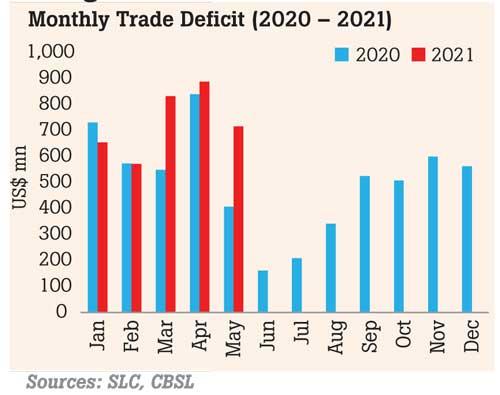Reply To:
Name - Reply Comment
Sri Lanka’s trade deficit expanded for the third consecutive month on a year-on-year (YoY) basis in May to US $ 716 million, from US $ 407 million a year ago, amid the rising global oil prices and recovery in imports.
However, this was a reduction compared to the month of April, where the trade gap hit a record high of US $ 889 million, as imports declined slightly and export earnings grew.
 In May, the earnings on merchandise exports recovered by 52 percent YoY and 9 percent month-on-month (MoM) to US $ 892 million.
In May, the earnings on merchandise exports recovered by 52 percent YoY and 9 percent month-on-month (MoM) to US $ 892 million.
Meanwhile, the expenditure on imports sharply rose by 61.71 percent YoY to US $ 1.6 billion but declined from US $ 1.7 billion recorded in April.
Terms of trade, which is the ratio of the price of exports to the price of imports, deteriorated by 11.5 percent YoY in May, as the prices of imports continued to rise while the prices of exports declined.
The cumulative deficit in the trade account widened to US $ 3.66 billion in the first five months of 2021, from US $ 3.1 billion recorded during the same period in 2020.
The largest contributors to the widening of the trade deficit in the five-month period were the US $ 587.9 million increase in the fuel import bill, US $ 284.4 million on textiles and textile articles and US $ 252.7 million on machinery and equipment. Meanwhile, the earnings from almost all key merchandise export categories continued to recover by double digits during the month, largely due to the low base effect. Industrial exports rose by 71.3 percent YoY and 6.2 percent MoM to US $ 687 million in May. In particular, textiles and garments, driven by a high number of export orders to the European Union (EU), rose by a notable 69.2 percent YoY to US $ 372.4 million and the rubber products (mainly rubber tyres and gloves) exports rose by 80.1 percent YoY to US $ 88.9 million.
Although the export earnings from petroleum products rose by 213 percent YoY to US $ 33.3 million, driven by the increase in earnings from bunker and aviation fuel exports, petroleum product exports declined on an MoM basis in May, mainly due to lower exports of other petroleum products such as naphtha. Similarly, gems, diamonds and jewellery exports rose by 133.5 percent YoY to US $ 16 million, while recording over US $ 8 million earning loss compared to the previous month. Export earnings from agricultural goods rose by 8.9 percent YoY to almost US $ 200 million, led by tea exports, which grew by 0.9 percent YoY to US $ 109.2 million, despite the decline in tea prices.
On an MoM basis, the earnings from all the subcategories of agricultural exports increased, except for seafood, natural rubber and unmanufactured tobacco.
The cumulative merchandise export income for the first five months rose by 33.3 percent YoY to US $ 4.7 billion.
Meanwhile, the import expenditure on consumer goods declined by 4.1 percent YoY and 9 percent MoM to US $ 253.6 million in May, driven by a 6.8 percent YoY decline in non-food consumer goods and 0.9 percent YoY decline in food and beverages. “Import expenditure on almost all subcategories of non-food consumer goods declined in May 2021, compared to April 2021, led by lower expenditure on home appliances (mainly refrigerators and televisions), medical and pharmaceuticals and clothing and accessories,” the Central Bank said.
The import expenditure on intermediate goods, driven by the fuel imports, rose by 115 percent YoY in May but declined by 2.8 percent over the previous month.
The fuel import bill surged 425.5 percent YoY to US $ 330.5 million in May but declined from US $ 413.2 million recorded in the previous month, due to lower import volumes, despite higher global prices, as travel restrictions impacted the fuel consumption in May.
“The average import price of crude oil increased to US $ 68.47 per barrel in May, compared to US $ 66.44 per barrel in April 2021 (US $ 25.44 per barrel in May 2020). Similarly, the average import price of refined petroleum increased to US $ 593.83 per metric tonne in May 2021, from US $ 571.23 per metric tonne in April 2021 (US $ 291.38 per metric tonne in May 2020),” the Central Bank noted.
In addition, the import expenditure on textiles and textile articles rose by 94.7 percent YoY to US $ 235.7 million in the month. Along with textiles and textile articles, the import expenditure on base metals (mainly iron and steel), chemical products, plastics and articles, rose on an MoM basis in May.
Meanwhile, the expenditure on investment goods increased by 27.9 percent YoY to US $ 308.1 million in May while recording a 12.7 percent decline over the previous month. “The month-on-month decline in May 2021 was driven by lower expenditure in machinery and equipment (mainly machinery and equipment parts, pumps, engineering equipment) and transport equipment (mainly lorries). However, expenditure on building material such as iron, steel and articles thereof as well as expenditure on transmission apparatus, electronic integrated circuits and medical and laboratory equipment that are categorised under machinery and equipment, increased in May 2021, compared to April 2021,” the Central Bank said.
Overall, the cumulative import expenditure increased by 26.2 percent YoY to US $ 8.35 billion in the five-month period. Meanwhile, in terms of the country’s major inflows to the current account, workers’ remittances continued to rise, recording a 6.6.percent YoY growth to US $ 460 million in May. The cumulative increase in the first five months topped 18 percent YoY to US $ 2.85 billion.